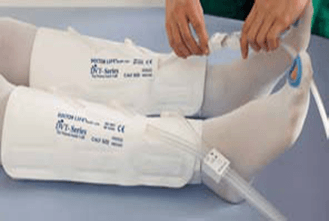


Deep vein thrombosis (DVT) is the formation of a blood clot ('thrombus') in a deep vein, most commonly of the calf and pelvis. Therefore, DVT and PE can arise mainly from knee or pelvis operation besides the internal, neurological or other operations. Healthy body keeps suitably the balance of the clotting system and the fibrinolytic system but thrombus can arise when this balance breaks from several medical conditions that can lead to DVT, such as physical trauma, cancer, older age (the strongest risk factor), varicose vein, antiphospholipid syndrome, surgery, immobilization (as with bed-rest, orthopedic casts, or during long-haul flights), heavy smoking, obesity, certain drugs and inborn tendencies to form clots known as thrombophilia. Virchow's triad, named after German physician Rudolf Virchow (1821-1902), describes the 3 categories of factors-
The formation process of DVT is that if the muscular part of calf with slow blood velocity or the endothelium of blood vessel is damaged, the coagulant starts by making the platelet bolus hardly by fibrinolytic system. If the coagulant thrombus becomes bigger, this thrombus is separated from blood vessel by the fibrinolytic system and can cause Pulmonary Embolism seriously.

Pulmonary embolism (PE) can be arisen mainly when DVT is delivered from dismal part to the proximal part, lung without suitable preventive treatment. Generally, 20% of thrombus generated in the deep vein of dismal part of body is transferred to proximal part. The ratio that PE can arise is 40~50%. Therefore, PE is discovered from patients with DVT of 50~60%.


DVT-2600 can accelerate the blood velocity two times more based on our clinic study by compressing two cuffs coincidently and sequentially differently from other overseas brands compressing by one cuff alternatively. Especially, as our coincident compression makes patients more comfortably, it is important function and technique that patient' satisfaction is higher than alternative compression.




